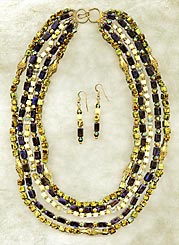China downplays risk to children from lead poisoning: report
http://www.reuters.com/article/2011/06/15/us-china-lead-pollution-idUSTRE75E14O20110615?feedType=nl&feedName=ushealth1100
This news article today in Reuters proves that the Chinese don’t care about their own children, much less ours. That’s why I continue to stress that Americans should not buy their cheap jewelry products for our daughters. We know that lead is a serious toxin and quite detremental to the intellectual development of children.
We as a nation, have gone to considerable lengths to irradicate lead from any where there may be exposure.Since the 1960′s when the data first was presented, we mandated that lead be removed from household paint. We have emmission standards.We regulate safety standards for workers to protect them from harm and exposure. We continue to this day conducting tests on children that grow up in urban areas. Just recently in New Orleans two playgrounds were closed due to unacceptable levels of lead in the soil. These grounds had been treated previously, and then declared “safe”. The ground when the grounds re-opened, were covered with a cushioned surface, designed to be a further protection. recently, testing indicated that the lead had come through. Therefore work immediately commenced to removed more soil from the ground, re-seal the ground and again add a protective covering.
Given that level of concern for lead in the environment, why then do parents continue to allow their daughters to wear toxic jewelry, that comes in direct contact with the skin?
Another reason this is untenable is while poisoning our children, we are paying them to do it! That transfer of wealth takes away from our economic strength as a nation. A simple way to put a dent in that trend would be to shop for American made jewelry for your children. There are many jewelry artists and jewelry stores in everyone’s community. Support them. They are using quality, safe materials, including lead-free pewter, surgical steel, silver gold, goldfill, sterling silver, or vermeil which is an overlay of high karat gold (18-24) over silver. Goldplate is a lower karat gold (8-10) over base metal, such as nickel, brass, copper. There are items to accommodate everyone’s budget. THis is especially true at local art shows. When local artists are supported, the money spent there goes right back into the community.
Furthermore, in a recent survey conducted by the prestegious Pam Danziger of Unity Marketing, there continues to be a strong perception that goods manufactured in the United States continues to be perceived as better quality, better made. more valuable.
“According to a recent study by Unity Marketing, affluent consumers associate certain attributes with countries of origin of luxury goods, and the USA is associated with the qualities affluents desire most.
That elevates manufacturing decisions beyond the sourcing department to marketing where place of manufacture becomes a core attribute of product branding and positioning. “If you make your luxury product in the wrong place, you can seriously harm your brand,” warns Pam Danziger president of Unity Marketing and author of the recently published Putting the Luxe Back in Luxury: How New Consumers Values Are Redefining How We Market Luxury (Paramount Market Publishing, 2011).
“Affluent consumers believe that the country where luxury brands are produced implies information about the product quality, regardless of whether the company’s manufacturing standards and their production facilities in far-flung locales are held to high standards. Luxury consumers identified a slate of key qualities most important to them when they shop for luxury goods, including craftsmanship, authenticity, classic nature, distinctiveness, and trustworthiness. These attributes line up with affluent perceptions about domestically-produced luxury goods,” says Danziger.
However, this does not mean that affluent consumers are solely choosing goods that benefit them individually, with no thought of national impact. “Affluent consumers recognize the positive impact that purchasing domestic luxury goods can have on U.S. jobs and on the country’s way of life, and they want to contribute to that. It is a much more altruistic form of luxury consumption than we saw before the recession hit,” says Danziger
With this in mind, I call on everyone in the American jewelry community, our manufacturers, jewelry designers, jewelry retailers and wholesalers, the media who cover the jewelry industry, all jewelry associations, local arts councils to come together to promote our American-made quality jewelry. This really is a no-brainer. It could only be to our mutual benefit. If we present a united front to our consumers, parents wouldn’t have to worry about the safety of the jewelry that our children wear.
Anne the Beadbear
http://www.beadbear.com
Subscribe to:
Post Comments (Atom)
Followers
Blog Archive
-
▼
2011
(23)
-
▼
June
(9)
- Commentary on breakdown of the Kimberley Process:
- Fine Jewelers Advised to Avoid Beads
- Why Taxing Online Shopping Is Unfair
- Origins of Republican Hate Speech Language in Amer...
- Why Not to Buy Chinese- Made Jewelry for Children
- Gold by Rajiv Mehta
- How to Avoid Walkouts and Other Customer Service D...
- Lead Violation Causes Children’s Jewelry Kit Recall
- Hanging Off The Wire: Liberty *Guest Blogger*
-
▼
June
(9)






















I may be stumbling around blindly in the dark, here, but it strikes me that this almost may be a bit like striving for process veganism? (The effort not just to avoid direct consumption of animal products, but any product that's tangentially involved in animal exploitation.)
ReplyDeleteCan all Chinese-manufacture mass produced jewelry items be realistically avoided completely? I don't mean to be flip; I honestly don't know.